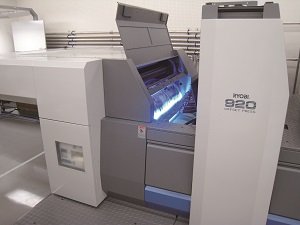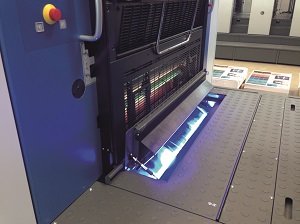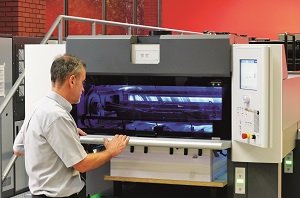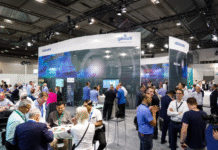
There’s been a steady rise in the use of UV inks for offset printing, driven mainly by improved technology and the demand for ever faster turnaround of jobs. The growth of digital printing, with its emphasis on short turnaround times, has forced the offset press world to speed up its own game. And one way of doing that is to reduce the drying times so that jobs can go straight into finishing. So, many printers have turned to UV-curable inks, which are touch dry as they leave the press and are relatively scratch proof. But conventional UV inks tend to leave quite a flat image that is not always suitable for commercial printing.
In recent years two alternative approaches to UV curing have emerged – low energy and LED UV. Both of these rely on tuning the inks very precisely to activate the UV curing process with a minimal amount of light energy. The downside of course is that this puts more pressure on the inks to perform, leading to higher ink prices. The trade-off between paying more for the inks or for the energy differs from one region to the next and according to the products and substrates being printed plus the business models of each individual print company so there’s no easy answer as to which system is best.
There are some distinct differences. The low energy approach is a variation on conventional UV although it does use less energy. Most low energy systems only need a single lamp, another saving over conventional UV, which normally requires three to six lamps depending on the sheet format. However, low energy systems still use an ion-doped lamp and these lamps still use a mechanical shutter, and still take time to warm up and cool down.
Light Emitting Diodes (LEDs), on the other hand, are an array of semi-conductors that produce light when connected to an electric current. There are no moving parts and LEDs typically last for over 15,000 to 20,000 hours, while conventional lamps have an average life span of just 1,000 hours. Also, LEDs can be turned on or off instantly, so there’s no time wasted waiting for the lamps to come up to temperature. This also means that the lifespan equates directly to hours spent printing with no degradation of the lamps over time as they deliver their full performance up until the point they fail. Besides offset, LED UV curing is already used in many wide format and inkjet label presses.
Most manufacturers will quote impressive numbers of press installations, though most of these are in Japan. Conventional UV curing has been popular in the Japanese market, mainly because it obviates the need for a coater or sealing unit and the jobs can be turned around quickly with no need to store work in progress while it dries. But the Japanese have also embraced solutions that cut energy usage, following the 2011 Fukushima Daiichi disaster and the subsequent shut down of most of the country’s nuclear power plants.
Both low energy and LED curing can offer dramatic energy savings over conventional oil-based inks since there’s no need to dry the inks. Matt Rockley, marketing and product executive for Heidelberg sheetfed presses in the UK, estimates this could be as much as 45% on an SRA sheet with an average 70% coverage. However, he points out that this alone is unlikely to offset the higher ink prices. This is particularly true of European markets, where energy prices are currently falling. But the real saving comes from turning jobs around faster.
It’s not just about the energy use. Rockley points out that there are no low migration inks suitable for either low energy or LED curing and so most packaging printers are still using conventional UV curing. Instead the newer systems are aimed at commercial printers looking to turn jobs around faster.

These newer inks have a very different look to them as Rockley explains, “Conventional UV inks are mainly made with plastic photopolymers so when you cure it you get more of a matt finish so there’s normally a UV gloss coating to enhance the product. Whereas the LE and LED UV are mixed with different products that give a glossier effect when dried so they look more like a conventional ink.”
Most vendors agree that there’s little difference in image quality between the low energy and LED systems as they both cure instantly. However, Rockley points out that simply following ISO12647 will produce a different look from an oil-based ink so that you might have to make adjustments to compensate. This could be an issue in producing a glossy magazine where the cover will have been printed on different stocks so that matching the inside cover, page 2 to page 3, could be more tricky, but essential given that many magazines will sell a double page advertisement in this position.
Neil Handforth, sales and marketing director at Apex Digital, distributors for Ryobi in the UK, says that the LED inks will work well with most substrates, coated or uncoated, adding, “The image quality is outstanding because the ink is dried instantly on the surface of the sheet so there’s no absorption to the stock.” This gives a very sharp dot for crisp images and uses less ink – Handforth estimates 10 to 15% less ink than a conventional system. However, this can vary considerably as some substrates are more absorbent than others.

Ryobi was one of the first press vendors to look at using LED curing, showing its first system as far back as drupa 2008. Ryobi usesPanasonic LED arrays, which can be fitted to many of its presses from the 2-up 520 series to the 8-up 920.
Hand forth says that the mainattractionis thatthe sheets are immediately dry and ready for guillotining orreworking. He adds, “There’s no ozone and no heat so you are not ducting anything out of the machine. Also, there’s no spray powder and most finishing operators will tell you that gets everywhere and clogs everything.”
ABC Print Group, based in Hereford in the UK, is one of the largest B3 printers in the country. ABC was the first UK company to order Ryobi’s LED UV, with a 924 SRA1 press. Managing director Mike Greene explained that he wanted to cut energy costs, adding, “Most drying solutions that produce a dry-to-the-touch sheettend to be a big draw on electricity, as well as being hungry on consumables such as coatings or varnish.”
The SRA1 format will produce 8-up A4 pages, which will be ready for finishing straight out ofthepress thanks to the LEDUV.Greenenoted, “Theproductivitygains of the configuration will be huge to a business like ours, and the savings on both maintenance and cleaning by not having to use spray powder are also important.”
KBA has also looked at LED curing, announcing a partnership with Air Motion Systems last year. AMS offers a number of different LED curing units, which are generally small enough to be retrofitted to existing presses. AMS will integrate its LED bars to KBA’s VariDry system. It can be fitted to new presses from the B3 Genius plus most ofthe Rapida presses from the B2 75 through to theSuper Large Format 205, and retrofitted to existing models. Carsten Barlebo, European director of AMS, says thatthe presses can operate attheirrated maximumspeeds up to 20,000 sheets an hour on the Rapida 106.
Meanwhile, Komori has developed a low energy curing system, which it calls HUV. It’s a single lamp located at the end of the press which produces touch-dry sheets straight out of the press.

Speedmaster 74
Platinum Press, based in Harrogate in the UK, bought a 4-color B2 H-UV press to replace a 5-colormachine.ManagingdirectorMarkPlummer says thatthe fastturnaround between jobs will enable him to increase productivity to such an extentthat the higher cost of the inks is less of a concern. He adds, “The ink dries on top of the uncoated stock so it’s very vibrant.”
Heidelberghas triedto keep anopenmindoverthe various options,developingits Drystar UV system for conventional UV and Drystar LE UV for low energy UV inks while also working with IFT to fit LED systems. However, Rockley says that the LED curing has been slow to take off in Europe because the inks are more expensive. He explains, “Thephoto initiators are finely tunedto 385nmso thedryingsystemhas to operate within that same window.” But he adds, “If you are printing to transparent films or plastics you might pick LED because it produces less heat.”
The otherfactorto consideris, of course, the ink. There has been a limited choice of ink but as the technology starts to become more popular so more ink suppliers are now coming on board. Thisnowincludes allthemajornames,fromToyo to Flint, SunChemical and the Huber Group as far asCMYK ink sets are concerned. There’s a more limited choice for Pantone colors and special inks such as metallic and opaque white. As a very rough guide, conventional UV inks are roughly double the cost of oil-based inks, while the low energy UV inks are nearly three time the cost, and the LED UV inks approximately fourtimes the cost of oil-based inks.
But, of course, time is money and the faster turnaround times can lead to higher producti- vity. This is especially so if combinedwitha smartworkflowto gang jobs together and offer the kind of short -run fast turnaround that has made digital so attractive, but with the quality associated with offset printing.










